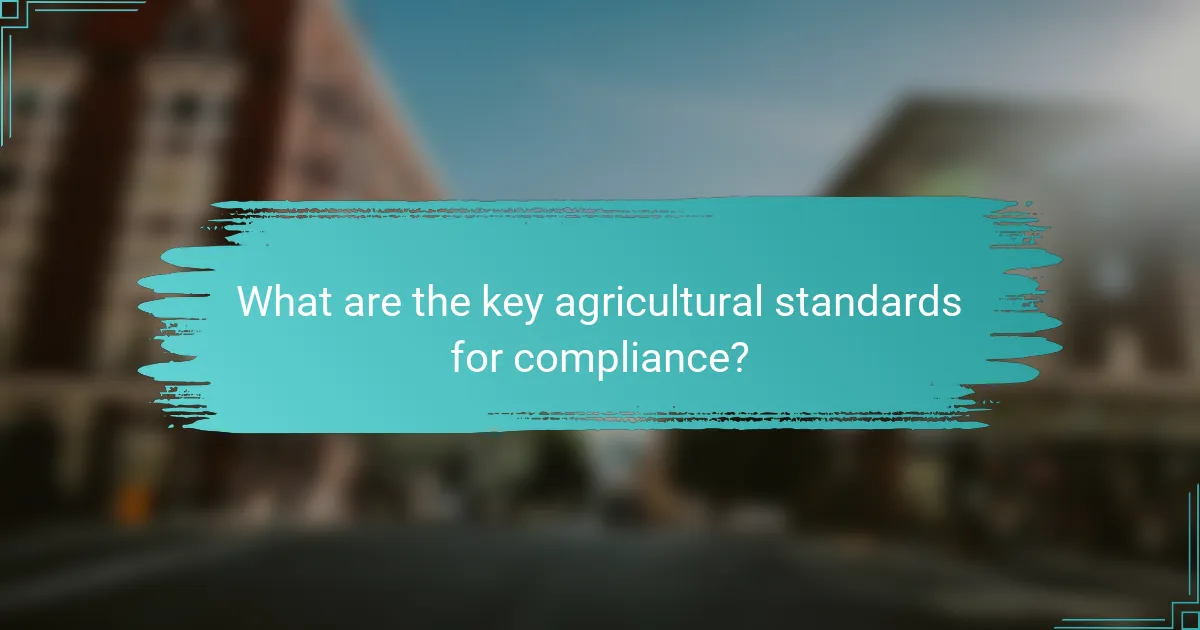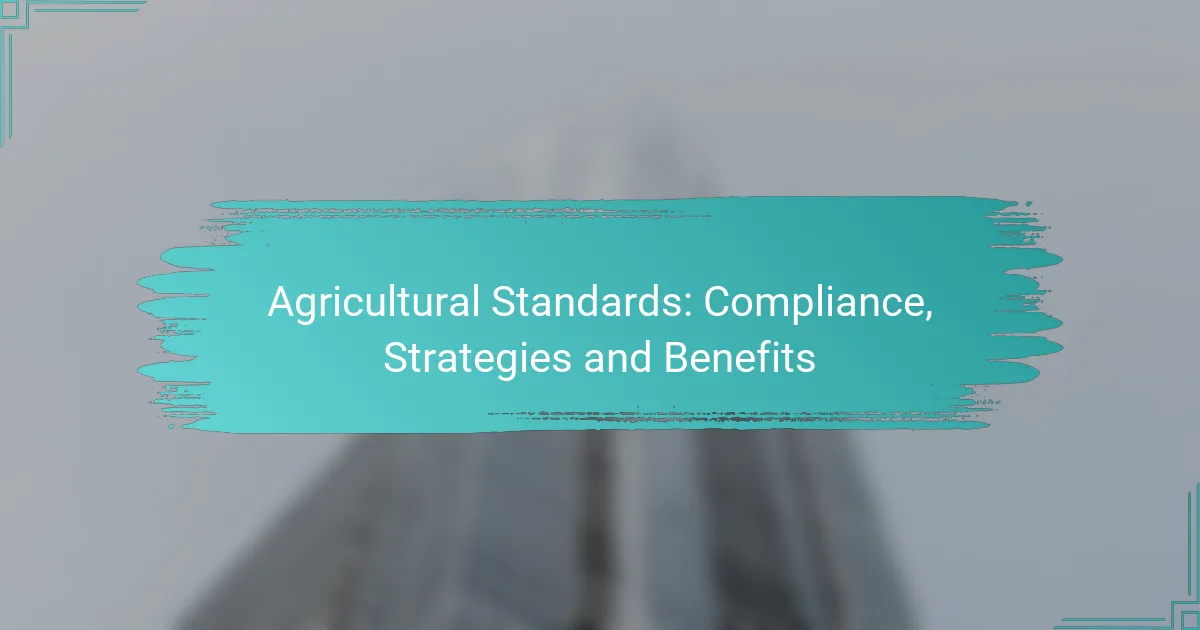Compliance with agricultural standards is essential for ensuring that farming practices meet safety, quality, and sustainability requirements. By implementing structured processes and adopting quality management practices, farmers can enhance market access and consumer trust while promoting responsible agricultural practices. The advantages of adhering to these standards include reduced waste, improved risk management, and a positive impact on overall sustainability in the agricultural sector.

What are the key agricultural standards for compliance?
Key agricultural standards for compliance ensure that farming practices meet safety, quality, and sustainability requirements. These standards help producers maintain market access and consumer trust while promoting responsible agricultural practices.
ISO 22000 for food safety management
ISO 22000 is an international standard that outlines the requirements for a food safety management system. It integrates principles from the Hazard Analysis and Critical Control Points (HACCP) system and is applicable to all organizations in the food supply chain.
To comply with ISO 22000, organizations must establish a food safety policy, conduct risk assessments, and implement control measures. Regular audits and management reviews are essential to ensure ongoing compliance and continuous improvement.
GlobalG.A.P. for good agricultural practices
GlobalG.A.P. is a certification program that promotes good agricultural practices, focusing on food safety, environmental sustainability, and worker welfare. It is widely recognized in international markets, particularly in Europe.
Farmers seeking GlobalG.A.P. certification must demonstrate compliance with specific criteria, including safe use of pesticides, proper waste management, and traceability of products. Regular inspections and documentation are crucial for maintaining certification.
USDA Organic standards for organic farming
The USDA Organic standards govern the production and labeling of organic agricultural products in the United States. These standards prohibit the use of synthetic fertilizers, pesticides, and genetically modified organisms (GMOs).
To achieve USDA Organic certification, farmers must follow strict guidelines for soil management, crop rotation, and pest control. Compliance requires thorough record-keeping and annual inspections by accredited certifying agents.
EU regulations on pesticide use
EU regulations on pesticide use aim to protect human health and the environment by controlling the application of chemical substances in agriculture. These regulations set maximum residue levels (MRLs) for pesticides in food products.
Farmers in the EU must adhere to these regulations by using approved pesticides and following application guidelines. Non-compliance can lead to penalties and loss of market access, making it essential to stay informed about current regulations.
FSSC 22000 for food safety certification
FSSC 22000 is a globally recognized food safety certification scheme that combines ISO 22000 with sector-specific prerequisites. It is designed for organizations in the food supply chain, ensuring a comprehensive approach to food safety management.
To obtain FSSC 22000 certification, companies must implement a food safety management system, conduct internal audits, and undergo third-party certification audits. This certification enhances credibility and can improve market opportunities for certified organizations.

How can farmers achieve compliance with agricultural standards?
Farmers can achieve compliance with agricultural standards by implementing structured processes and systems that align with regulatory requirements. This involves adopting quality management practices, ensuring staff are well-trained, conducting regular audits, and utilizing technology to streamline compliance efforts.
Implementing quality management systems
Quality management systems (QMS) help farmers establish consistent practices that meet agricultural standards. A robust QMS includes defining quality objectives, documenting processes, and regularly reviewing performance. For example, farmers can use the ISO 9001 standard as a framework to enhance their operational efficiency and product quality.
To implement a QMS effectively, farmers should engage their teams in the process, ensuring everyone understands their roles. Regular updates and feedback loops can help maintain compliance and adapt to changing regulations.
Regular training and education programs
Training and education are critical for ensuring that all staff members understand agricultural standards and compliance requirements. Regular workshops and training sessions can cover topics such as safe pesticide use, soil management, and record-keeping practices. This proactive approach minimizes the risk of non-compliance.
Farmers should consider tailoring training programs to specific roles within their operations. For instance, field workers may need different training than management staff, focusing on practical applications relevant to their daily tasks.
Conducting internal audits
Internal audits are essential for assessing compliance with agricultural standards and identifying areas for improvement. Farmers should schedule audits regularly, ideally quarterly, to ensure ongoing adherence to regulations. These audits can help uncover potential issues before they lead to significant problems.
During an internal audit, farmers should review documentation, inspect facilities, and evaluate processes. It’s beneficial to create a checklist covering all compliance areas to streamline the audit process and ensure thoroughness.
Utilizing compliance software tools
Compliance software tools can significantly simplify the management of agricultural standards. These tools help farmers track compliance requirements, manage documentation, and streamline reporting processes. Many software solutions offer features like real-time monitoring and alerts for upcoming deadlines.
When selecting compliance software, farmers should consider factors such as usability, integration with existing systems, and support services. Investing in a reliable tool can save time and reduce the risk of non-compliance, ultimately leading to better operational efficiency.

What are the benefits of adhering to agricultural standards?
Adhering to agricultural standards offers numerous advantages, including improved market access, enhanced consumer trust, reduced waste, and better risk management. These benefits not only help businesses thrive but also contribute to overall sustainability in the agricultural sector.
Improved market access and competitiveness
Complying with agricultural standards can significantly enhance market access for producers. Many retailers and export markets require adherence to specific standards, which can open doors to new opportunities and increase competitiveness.
For example, organic certification can allow farmers to tap into premium markets where consumers are willing to pay higher prices for certified products. This can lead to increased revenue and a stronger market position.
Enhanced consumer trust and brand reputation
Adhering to recognized agricultural standards fosters consumer trust and enhances brand reputation. When consumers see certifications, they are more likely to believe that the products are safe, high-quality, and ethically produced.
Building a strong reputation through compliance can lead to customer loyalty and repeat business. Brands that communicate their commitment to standards often enjoy a competitive edge in the marketplace.
Reduction in waste and operational costs
Following agricultural standards can lead to more efficient practices, resulting in reduced waste and lower operational costs. By implementing best practices, producers can optimize resource use, minimize spoilage, and streamline processes.
For instance, adopting precision agriculture techniques can help farmers apply inputs more effectively, reducing excess use of fertilizers and pesticides, which in turn lowers costs and environmental impact.
Better risk management and compliance assurance
Adhering to agricultural standards helps in managing risks associated with production and market fluctuations. Compliance provides a framework for identifying and mitigating potential issues before they escalate.
Additionally, maintaining compliance with regulations can protect businesses from legal liabilities and penalties. Regular audits and adherence to standards ensure that producers remain accountable and can respond proactively to challenges in the agricultural landscape.

What strategies can support compliance in the agricultural sector?
Strategies for compliance in the agricultural sector focus on systematic planning, collaboration, and technology use. By developing a clear roadmap, engaging with industry associations, and leveraging technology for monitoring, agricultural businesses can effectively meet regulatory standards and improve operational efficiency.
Developing a compliance roadmap
A compliance roadmap outlines the specific steps an agricultural business must take to meet regulatory requirements. This includes identifying applicable standards, assessing current practices, and setting measurable goals. Regularly reviewing and updating the roadmap ensures that the business stays aligned with evolving regulations.
Key components of a compliance roadmap include timelines, responsible parties, and resource allocation. For example, a farm might allocate budget for training staff on new food safety standards while setting a deadline for implementing necessary changes.
Engaging with industry associations
Industry associations provide valuable resources and support for compliance in agriculture. By joining these organizations, businesses gain access to best practices, regulatory updates, and networking opportunities. This engagement can lead to collaborative efforts that enhance compliance across the sector.
Participating in workshops and seminars offered by these associations can help agricultural professionals stay informed about compliance trends and challenges. Additionally, these associations often advocate for favorable regulations, benefiting their members.
Leveraging technology for monitoring
Technology plays a crucial role in monitoring compliance within the agricultural sector. Tools such as farm management software, sensors, and data analytics can help track adherence to regulations in real-time. This proactive approach allows for quick identification of potential compliance issues.
For instance, using IoT devices to monitor soil health can ensure that a farm meets environmental regulations. Additionally, digital record-keeping simplifies documentation processes, making it easier to demonstrate compliance during audits or inspections.

What are the prerequisites for implementing agricultural standards?
Implementing agricultural standards requires a clear understanding of the specific regulations, resources, and practices relevant to the agricultural sector. Key prerequisites include stakeholder engagement, knowledge of applicable standards, and the establishment of a compliance framework.
Understanding the relevant agricultural standards
Familiarity with the agricultural standards applicable to your region is crucial. These standards may include local regulations, international guidelines, and industry best practices. For instance, in the European Union, compliance with the Common Agricultural Policy (CAP) is essential for farmers seeking subsidies.
Researching and identifying the specific standards that apply to your operations can help streamline the implementation process. This may involve reviewing documents from regulatory bodies or industry associations that outline the necessary criteria.
Engaging stakeholders
Involving stakeholders such as farmers, suppliers, and consumers is vital for successful implementation. Engaging these groups can provide insights into practical challenges and expectations regarding agricultural standards. Regular communication fosters collaboration and ensures that everyone is aligned with the goals of compliance.
Consider organizing workshops or meetings to discuss the standards and gather feedback. This approach not only enhances understanding but also builds a sense of ownership among stakeholders.
Establishing a compliance framework
A robust compliance framework is essential for monitoring adherence to agricultural standards. This framework should outline processes for documentation, training, and auditing. For example, creating a checklist for compliance can help ensure that all necessary steps are followed consistently.
Regular audits and assessments can identify gaps in compliance and provide opportunities for improvement. Utilizing software tools for tracking compliance can also streamline this process, making it easier to maintain records and generate reports.
